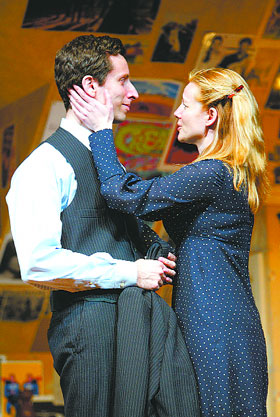Laura Linney excels as an archeologist unable to bury her past
In the money-grubbing 1980s, when Donald Margulies wrote “Sight Unseen,” a scintillating indictment of the art world, prices for paintings had reached deranged proportions.
Artists and their egos (think Julian Schnabel, Jean-Michel Basquiat) became as much a commodity as the works themselves. Corporations like Saatchi & Saatchi and Union Carbide snapped up oversize canvases at auctions, breaking records, to flout in their lobbies like prized mounted moose heads.
Twelve years since its premiere, the Manhattan Theatre Club (MTC) is staging the first revival of “Sight Unseen” on Broadway. And while Saatchi has long since liquidated the bulk of its treasures, the play’s themes of overnight celebrity, sizzle over substance, and inflated worth still ring true today. Besides, Margulies packed in plenty of other motifs to ponder.
And what a fine revival it is.
This thoroughly engrossing drama, set in 1991, centers on Jonathan Waxman, a hotshot, young, Brooklyn-born painter whose artwork is in such demand that patrons are willing to buy sight unseen, even before they’ve actually been painted. While in England for a major retrospective of his work, Jonathan visits Patricia, whom he callously dumped 15 years earlier, and her prickly husband, Nick, in their drafty old farmhouse. The couple has settled for a quiet, hardscrabble existence as archaeologists and has little interest in the go-go art world. Patricia, an avowed expatriate, claims to want little to do with Jonathan, either.
“I buried you years ago,” Patricia snarls.
Maybe so, but anyone can sense that recrimination boils just below the surface.
The virtuoso Laura Linney (recently seen on Broadway in “The Crucible” and in the film “Mystic River”) who plays Patricia, is well versed in the nuances of “Sight Unseen,” having assumed the secondary role of Grete in the original MTC production. Her delicately understated performance is mesmerizing, calmly shifting the focus away from the conceited, loudmouthed Jonathan. When Linney, who can convey a decade’s weight of doubt with just a sigh, bemoans “leisure is hard,” we somehow know precisely what she means.
The only tangible relic of their doomed love affair—a portrait Jonathan painted of Patricia when they first met—sits prominently over the fireplace in the next room. (We never actually see the picture, or any of his art, for that matter, freeing us to paint our own Waxman collection in our imaginations.)
Jonathan, who acts as if he’d forgotten about the painting, is stunned by its mastery. He regards this early picture as a touchstone by which all his other accomplishments, artistic or otherwise, can be measured. It certainly would serve as an exclamation point to his body of work in the upcoming exhibition.
The searing Vanity Fair headlines written about Jonathan—“Bad Boy or Visionary?” and “Charlatan or Genius?”—reverberate throughout the play. For me, the question that tugged most sharply was whether Jonathan was ever really interested in mending fences with his lost soul mate, or was he singularly obsessed with reclaiming his lost painting?
Inserted into “Sight Unseen” are two scenes from an interview between the art world darling and Grete, a sexpot critic for a German art magazine, who mounts an attack soliciting the true impetus behind his work. This unexpected clash between Jewish artist and German journalist makes for some harrowing moments.
For this story is about infinitely more than art. It’s about digging up remnants of past relationships—whether between estranged lovers or historically embattled races—and then assessing their value.
There are also flashbacks to a pivotal scene in the home where Jonathan grew up, where we witness the breakup between him and Patricia, and to a magical afternoon in an art studio, where the young artist falls in love with his muse.
Despite Linney’s luminous star turn, she allows her cast-mates to shine brightly. Ben Shenkman, whose performance opposite Mary-Louise Parker in “Proof” won him a Tony nomination (he also appeared in HBO’s “Angels in America”), imbues Jonathan with just the right blend of bravado and nebbish vulnerability. Also powerful are Byron Jennings as Nick and Ana Reeder as Grete, though at times both actors flirt dangerously with caricature.
Daniel Sullivan, who won a Tony Award for “Proof” and has scores of other productions on Broadway and beyond to his credit, directs with his usual golden touch.
Designer Douglas W. Schmidt makes brilliant use of the newly renovated Biltmore Theatre, creating soaring interiors with amazingly angled, peaked ceilings. His stupendous set of the sun-dappled, cream-hued art studio, with its impossibly mammoth radiator and vast, diaphanously curtained window, appears as if from a dream.
How fitting for this welcome dream of a production.



































